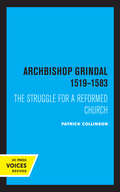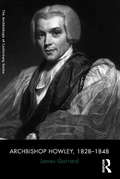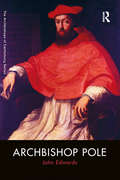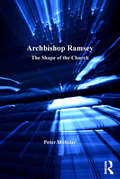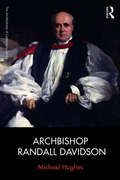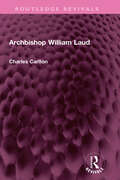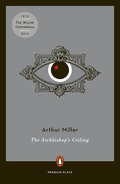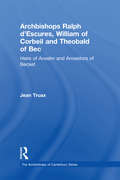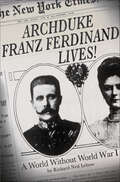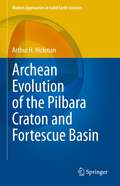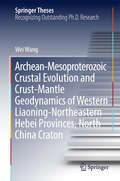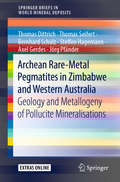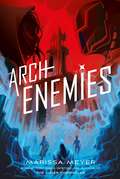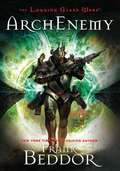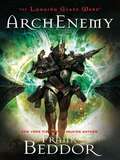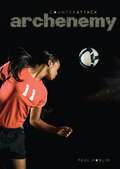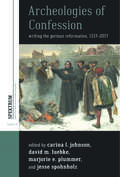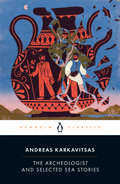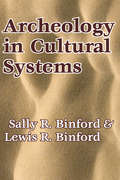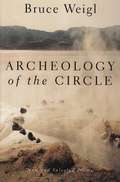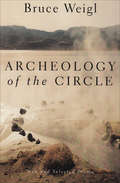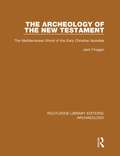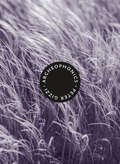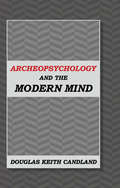- Table View
- List View
Archbishop Grindal, 1519-1583: The Struggle for a Reformed Church
by Patrick CollinsonThis title is part of UC Press's Voices Revived program, which commemorates University of California Press’s mission to seek out and cultivate the brightest minds and give them voice, reach, and impact. Drawing on a backlist dating to 1893, Voices Revived makes high-quality, peer-reviewed scholarship accessible once again using print-on-demand technology. This title was originally published in 1977.
Archbishop Howley, 1828-1848 (The Archbishops of Canterbury Series)
by James GarrardWilliam Howley, Archbishop of Canterbury 1828-1848, led the Church of England during the beginning and expansion of the Oxford Movement, at a time when the precursor to the Church Commissioners was established, and during the momentous debates and decisions in Parliament which saw the final retreat from the myth of an all Anglican legislature. Howley’s chairmanship of the commissions of the 1830s and 1840s which began the gargantuan task of reforming the Church’s practices and re-arranging its finances, made him an object of fury and scorn to some of those who benefited from things as they were, most especially in the cathedrals. Exploring the central events and debates within the Church of England in the first half of the nineteenth century, this book draws on primary and secondary evidence about Howley’s career and influence. A section of original sources, including his Charges and other public documents, correspondence and speeches in the House of Lords, places Howley’s achievements in proper context and illustrates his prevailing concerns in education, the establishment and political reform, relationships with the Tractarians, and in the early stages of Church reform. Dealing thematically with many of the issues faced by Howley, and exploring his own High Church theological views in historical context, James Garrard offers a fruitful re-appraisal of the intellectual, spiritual and ’party’ context in which Howley moved.
Archbishop Pole (The Archbishops of Canterbury Series)
by John EdwardsThis fresh exploration of the life, work and writing of Archbishop Pole, focuses particularly on Pole’s final years (1556-58) as Archbishop of Canterbury. Fully integrating Pole’s English and Continental European experiences, John Edwards places these in their historical context and signposts lessons for contemporary issues and concerns. Stressing the events and character of Pole's 'English' life, up to his exile in the 1530s, as well as in his final years in England (1554-58), this book explores his close relationship, both genealogical and emotional, with Henry VIII and Mary I. Portraying Pole as a crucial figure in the Catholic-Protestant division, which still affects Britain today, this book details the first, and so far last, attempt to restore Roman Catholicism as the 'national religion' of England and Wales by telling the life-story of the hinge figure in forging English religious and political identity for several centuries. The final section of this book draws together important and illuminating source material written by Pole during his years as Archbishop of Canterbury.
Archbishop Ramsey: The Shape of the Church (The Archbishops of Canterbury Series)
by Peter WebsterArchbishop Michael Ramsey’s archiepiscopate from 1961 to 1974 saw profound renegotiations of the relationship of the Church of England with its own flock, with the nation more widely, with the Anglican church worldwide, and with the other Christian churches. Drawing from unique source material in the Lambeth Palace Library archives and reproducing many original writings of Ramsey for the first time, this book explores key questions which surround Ramsey’s tenure. How did Ramsey react to the rapid hollowing-out of the regular constituency of the church whilst at the same time seeing sweeping changes in the manner in which the church tried to minister to those members? What was his role in the widening of the church's global vision, and the growing porousness of its borders with other denominations? And how did the nature of the role of archbishop as figurehead change in this period?
Archbishop Randall Davidson (The Archbishops of Canterbury Series)
by Michael HughesRandall Davidson was Archbishop of Canterbury for quarter of a century. Davidson was a product of the Victorian ecclesiastical and social establishment, whose advance through the Church was dependent on the patronage of Queen Victoria, but he became Archbishop at a time of huge social and political change. He guided the Church of England through the turbulence of the Edwardian period, when it faced considerable challenges to its status as the established Church, as well as helping shape its response to the horrors of the First World War. Davidson inherited a Church of England that was sharply divided on a range of issues, and he devoted his career as Archbishop to securing its unity, whilst ensuring that its voice continued to be heard both nationally and internationally. A modest and pragmatic man, he was widely respected both within the Church of England and beyond, helping to find solutions to a range of political and ecclesiastical problems. This book explores Davidson’s role within the Church and in the life of Britain more broadly during his time at Canterbury. It includes a large selection of documents that help to reveal the Archbishop’s character and cast light on the way in which he carried out his varied and demanding duties.
Archbishop William Laud (Routledge Revivals)
by Charles CarltonFirst published in 1987, Archbishop William Laud shows how Laud dragged the English Church, and with it English society, towards a new and radical version of Anglicanism. Carlton presents Laud in the context of his times, showing how closely his personal life and character were woven into his political and religious career. By using Laud’s personal papers, his letters and diary, Carlton draws a psychological profile of this most insecure man. He analyses Laud’s dreams, revealing that both awake and asleep the archbishop was haunted by some guilty secret, obsessed with details, bedevilled by enemies and conspiracies, while being both ashamed and proud of his own humble origins. The tensions between Laud’s private and public worlds made him seem cruel, thus turning him into the perfect scapegoat for the failure of the king’s policies. This book will be of interest to students of history, literature and psychology.
The Archbishop's Ceiling
by Arthur MillerA masterful mix of art, sex, and politics behind the Iron Curtain, by America's greatest dramatist In an unnamed Eastern European capital, four writers gather in what was once an archbishop's palace. There is Adrian, a successful American author struggling with questions about a novel he has set in the city, and Marcus, a once-imprisoned radical who has become a darling of the current regime. Finally, there is Sigmund, perhaps the country's greatest living writer, who refuses to compromise his artistic integrity to appease the regime. Between them all is Maya, a poet and actress who has been a mistress and muse to each man. The ornately decorated ceiling above them may or may not be bugged, and the group carefully watches their words as they discuss the play's central dilemma - should Sigmund stay and resist the oppressive state, or should he defect and pursue his art in freedom? Their conversation poses crucial questions about mass surveillance, morality, and the authenticity of art, and remains as relevant today as it was during the height of the Cold War.
Archbishops Ralph d'Escures, William of Corbeil and Theobald of Bec: Heirs of Anselm and Ancestors of Becket (The Archbishops of Canterbury Series)
by Jean TruaxThe first two archbishops of Canterbury after the Norman Conquest, Lanfranc and Anselm, were towering figures in the medieval church and the sixth archbishop, the martyred Thomas Becket, is perhaps the most famous figure ever to hold the office. In between these giants of the ecclesiastical world came three less noteworthy men: Ralph d'Escures, William of Corbeil, and Theobald of Bec. Jean Truax's volume in the Ashgate Archbishops of Canterbury Series uniquely examines the pontificates of these three minor archbishops. Presenting their biographies, careers, thought and works as a unified period, Truax highlights crucial developments in the English church during the period of the pontificates of these three archbishops, from the death of Anselm to Becket. The resurgent power of the papacy, a changed relationship between church and state and the expansion of archiepiscopal scope and power ensured that in 1162 Becket faced a very different world from the one that Anselm had left in 1109. Selected correspondence, newly translated chronicle accounts and the text and a discussion of the Canterbury forgeries complete the volume.
Archduke Franz Ferdinand Lives!: A World Without World War I
by Richard Ned LebowArchduke Franz Ferdinand Lives! presents an intellectually invigorating set of hypotheticals about the twentieth century--had we been smart enough to avoid World War I.The "Great War" claimed nearly 40 million lives and set the stage for World War II, the Holocaust, and the Cold War. More than one hundred years later, historians are beginning to recognize how unnecessary it was. In Archduke Franz Ferdinand Lives!, acclaimed political psychologist Richard Ned Lebow examines the chain of events that led to war and what could reasonably have been done differently to avoid it. In this highly original and intellectually challenging book, he constructs plausible worlds, some better, some worse, that might have developed. He illustrates them with "what-if" biographies of politicians, scientists, religious leaders, artists, painters, and writers, sports figures, and celebrities, including scenarios where: there is no Israel; neither John Kennedy nor Barack Obama become president; Curt Flood, not Jackie Robinson, integrates baseball; Satchmo and many Black jazz musicians leave for Europe, where jazz blends with klezmer; nuclear research is internationalized and all major countries sign a treaty outlawing the development of atomic weapons; Britain and Germany are entrapped in a Cold War that threatens to go nuclear; and much more.
Archduke of Sarajevo
by Gordon Brook-ShepherdA biography of the ill-fated Franz-Ferdinand whose assassination in 1914 set in motion the train of events that led to World War One
Archean Evolution of the Pilbara Craton and Fortescue Basin (Modern Approaches in Solid Earth Sciences #24)
by Arthur H. HickmanOne of today’s major geoscientific controversies centres on the origin of the Archean granite‒greenstone terranes. Is the geology of these scattered remnants of our planet’s early crust consistent with the theory that modern-style plate-tectonic processes operated from the early Archean, or does it indicate that tectonic and magmatic processes were different in the Archean? Earth has clearly evolved since its initial formation, so at what stage did its processes of crustal growth first resemble those of today? The logical place to seek answers to these intriguing and important questions is within the best-preserved early Archean crust. The Pilbara region of northwest Australia is internationally famous for its abundant and exceptionally well-preserved fossil evidence of early life. However, until recently the area has received much less recognition for the key evidence it provides on early Archean crustal evolution. This book presents and interprets this evidence through a new stage-by-stage account of the development of the Pilbara’s geological record between 3.53 and 2.63 Ga. The Archean Pilbara crust represents one fragment of Earth’s oldest known supercontinent Vaalbara, which also included the Kaapvaal Craton of southern Africa. Recognition of Vaalbara expands the background database for both these areas, allowing us to more fully understand each of them.
Archean-Mesoproterozoic Crustal Evolution and Crust-Mantle Geodynamics of Western Liaoning-Northeastern Hebei Provinces, North China Craton (Springer Theses)
by Wei WangThis thesis presents geological, petrological, geochemical, and zircon U-Pb-Lu-Hf isotopic field data for representative Precambrian lithologies in the Western Liaoning-Northeastern Hebei Provinces along the northern margin of the North China Craton (NCC). It describes late Neoarchean (2. 64-2. 48 Ga) supracrustal metavolcanic rocks and granitoid gneisses; late Paleoproterozoic (1. 72-1. 68 Ga) Jianping alkaline plutons and Pinggu alkaline volcanic rocks; and newly discovered ~1. 23 Ga mafic dykes. The nature of magma sources and genesis of each magmatic episode are investigated, and the Precambrian (~2. 6-1. 2 Ga) lithospheric mantle evolution and crust-mantle interaction processes are established for the first time -aspects that provide important constraints in our understanding of the Precambrian crustal evolution and geodynamic processes in the region studied.
Archean Rare-Metal Pegmatites in Zimbabwe and Western Australia: Geology and Metallogeny of Pollucite Mineralisations (SpringerBriefs in World Mineral Deposits)
by Thomas Dittrich Thomas Seifert Bernhard Schulz Steffen Hagemann Axel Gerdes Jörg PfänderLithium-cesium-tantalum (LCT) pegmatites are important resources for rare metals. For Cs, only the LCT pegmatites with the zeolite group mineral pollucite at Bikita (Zimbabwe Craton) and Tanco (Superior Province Craton) are of commercial importance. Common characteristics of world-class LCT pegmatite deposits include their Meso- to Neoarchean age and geological setting within greenstone belt lithologies on Archean Cratons.This study presents the first coherent and comparative scientific investigation of five major LCT pegmatite systems from the Yilgarn, Pilbara and Zimbabwe Craton. For the evaluation of their Cs potential and of the genetic concepts of pollucite formation, the pegmatites from Wodgina, Londonderry, Mount Deans and Cattlin Creek were compared to the Bikita pollucite mineralization. The integration of the new data (e.g., geochronological and radiogenic isotope data) into the complex geological framework: 1) enhances our knowledge of the formation of LCT pegmatite systems, and 2) will contribute to the further exploration of additional world-class LCT pegmatite deposits, which 3) may host massive pollucite mineralisations.
Archenemies (Renegades #2)
by Marissa Meyer<p>Nova’s double life is about to get a lot more complicated: <p>As Insomnia, she is a full-fledged member of the Renegades, a syndicate of powerful and beloved superheroes. She works with Adrian’s patrol unit to protect the weak and maintain order in Gatlon City. <p>As Nightmare, she is an Anarchist - a group of of villains who are determined to destroy the Renegades. Nova wants vengeance against the so-called heroes who once failed her when she needed them most. <p>But as Nova, her feelings for Adrian are deepening, despite the fact that he is the son of her sworn enemies and, unbeknownst to Nova, he has some dangerous secrets of his own. <p>In this second installment of the Renegades trilogy, Nova, Adrian, and the rest of their crew – Ruby, Oscar, and Danna -- are faced with escalating crime in Gatlon City, while covert weapons and conflicting missions have Nova and Adrian questioning not only their beliefs about justice, but also the feelings they have for each other. <p>The line between good and evil has been blurred, but what's clear to them both is that too much power could mean the end of their city – and the world – as they know it.</p>
ArchEnemy (The Looking Glass Wars #3)
by Frank BeddorDiscover the fate of Wonderland -- and imagination itself -- in this riveting conclusion to "The Looking Glass Wars" trilogy. The Heart Crystal's power has been depleted, and Imagination along with it. The people of Wonderland have all lost their creative drive, and most alarmingly, even Queen Alyss is without her powers. There is some comfort in the fact that the vicious Redd Heart seems to be similarly disabled. Amazingly, she is attempting to team up with her enemy, Alyss, in order to reclaim Wonderland from King Arch. Alyss might have no choice but to accept Redd's overtures, especially when she begins to receive alarming advice from the caterpillar oracles.
ArchEnemy
by Frank BeddorThe Heart CrystalÕs power has been depleted, and Imagination along with it. The people of Wonderland have all lost their creative drive, and most alarmingly, even Queen Alyss is without her powers. But at least the vicious Redd Heart seems to be similarly disabled. Amazingly, she is attempting to team up with her enemy, Alyss, in order to reclaim Wonderland from King Arch. Alyss might have no choice but to accept ReddÕs overtures, especially when she begins to receive alarming advice from the caterpillar oracles. . . .
Archenemy (Counterattack)
by Patrick HuellerAs a defender for the Fraser High girls soccer team, Addie used to be ready for anything. There was no play she couldn't shut down. But now the biggest threat on the field is one of her teammates . . . who is also Addie's former best friend. When Eva Riley moved to town, she and Addie became super close. But when Eva wanted to be more than friends, Addie put soccer first instead. Suddenly Eva's sending Addie mean notes. Then she's screwing up Addie's plays. After a while, Addie's not sure she even wants her friend back. She has to worry about other things—like keeping her spot on the team after Eva's latest act of sabotage.
Archeologies of Confession: Writing the German Reformation, 1517-2017 (Spektrum: Publications of the German Studies Association #16)
by David M. Luebke Jesse Spohnholz Carina L. Johnson Marjorie E. PlummerModern religious identities are rooted in collective memories that are constantly made and remade across generations. How do these mutations of memory distort our picture of historical change and the ways that historical actors perceive it? Can one give voice to those whom history has forgotten? The essays collected here examine the formation of religious identities during the Reformation in Germany through case studies of remembering and forgetting—instances in which patterns and practices of religious plurality were excised from historical memory. By tracing their ramifications through the centuries, Archeologies of Confession carefully reconstructs the often surprising histories of plurality that have otherwise been lost or obscured.
The Archeologist and Selected Sea Stories
by Andreas KarkavitsasTranslated into English for the first time, The Archeologist is a landmark of Greek national literature, and an important document in the history of archeology and classicism. Published for the bicentennial year of the outbreak of the Greek War of Independence.A Penguin ClassicThe year 2021 marks the bicentennial of the outbreak of the Greek War of Independence. This historical milestone provides the impetus for a new period of intensified reflection on the past, present, and future of Greece, especially in light of recent financial and humanitarian challenges the country has found itself facing: the debt crisis that began in the last days of 2009 and the migration crisis five years later. These crises had already stirred renewed and often animated debate about Greek national identity, especially in relation to Europe, and the legacy of classical antiquity remains central to how that relationship is imagined. Where does Greece fit into the modern world and what role, if any, should its celebrated and idealized antiquity play in the country's national identity? More than a century ago, Karkavitsas's The Archeologist (1904) helped to articulate and frame these kinds of questions. The work is an allegory of Greek nationalism that is stylized as a folktale about Aristodemus and Dimitrakis Eumorphopoulos, two brothers and descendants of the illustrious Eumorphopoulos line. For centuries, the family had been persecuted by the Khan family, but when the Khan dynasty starts to topple, the Eumorphopoulos family resolves to regain their ancestral lands and restore their line's ancient glory. Yet the two brothers disagree about the best path forward into the future. Aristodemus insists, to the point of mania, that they must look only to the ancient past—to the family's ancient language, texts, religion, and monuments; Dimitrakis, on the other hand, exuberantly embraces the present. The Archeologist, however, attempts to map and dramatize the tensions that were violently brewing in the Balkans at the turn of the twentieth century and which, within a decade of the work's publication, would contribute to the outbreak of World War I. Also included in this edition are a selection of "sea tales," which Karkavitsas heard from sailors during his extensive time aboard ships in the Mediterranean. Considered as indigenous to Greek literature, the four sea stories represent some of the best known of the Tales from the Prow. "The Gorgon," one of Karkavitsas's shortest sea stories, is also one of the most famous.
Archeology in Cultural Systems
by Lewis R. BinfordArcheology shares with other anthropological sciences the goal of explaining differences and similarities among cultural systems. Sally R. Binford and Lewis R. Binford, therefore are concerned with theory and arguments which treat problems of the interrelationship of cultural variables with explanatory value. Archeology in Cultural Systems is devoted to four different aspects of archeology.This book progresses from theoretical-methodological discussions to specific consideration of archeological materials. It focuses on the analysis of archeological remains from a single site. Its concern is primarily with recognizing, measuring and explaining variability in the form and distribution of a site's cultural remains. The authors argue that internal variability derives from the composition and distribution of societal segments represented at the site. The work then shifts to study of archeological components (or their attributes) and seeks explanations for observed differences and similarities. A final section of the volume comments and discusses materials in the volume.Archeology in Cultural Systems is not a monolithic presentation of any particular school of archeological thought. There are common interests and many points of agreement among the authors, but there is also diversity of opinion on several points. These points are the focus of research here.
Archeology of the Circle: New and Selected Poems
by Bruce WeiglA range of poems from this contemporary poet, including work published as far back as the mid-1970s as well as new creations.
Archeology of the Circle: New and Selected Poems
by Bruce WeiglWith Song of Napalm, Bruce Weigl established himself as a poet of incomparable power and lyric fury, whose work stands as an elegy to the countless lives dramatically altered by war. Archeology of the Circle brings together the major work of one of America’s greatest poets. Collected here for the first time from eight volumes of poetry and spanning two decades, Archeology of the Circle also includes Weigl’s most recent poems, which take a dramatic turn toward a hard-bitten and sensuous lyric. Out of the horror of individual experience, Bruce Weigl has fashioned poetry that offers solace to disillusionment and bears transcendent resonance for all of us. Archeology of the Circle illustrates Bruce Weigl’s remarkable creative achievements and signifies his own personal and spiritual salvation through his writing.
The Archeology of the New Testament: The Mediterranean World of the Early Christian Apostles (Routledge Library Editions: Archaeology #154)
by Jack FineganThis book provides an introduction to the Mediterranean world in which the early Christian apostles moved. Drawing on the geographic setting and available archaeological materials to create a sense of the contemporary environment, the book traces the 15,000 mile travels of Paul, whose world was also the world of Peter, John, and many other early Christians. The author presents a complete chronology for the major apostles based on his integration of existing histories, literary accounts, and archaeological information with new discoveries and new theories on dating New Testament events and documents. The text is lavishly illustrated and as fascinating now as when originally published in 1981.
Archeophonics (Wesleyan Poetry Ser.)
by Peter GizziSoulful and intricate lyrics make this Gizzi's strongest book to dateArcheophonics is the first collection of new work from the poet Peter Gizzi in five years. Archeophonics, defined as the archeology of lost sound, is one way of understanding the role and the task of poetry: to recover the buried sounds and shapes of languages in the tradition of the art, and the multitude of private connections that lie undisclosed in one's emotional memory. The book takes seriously the opening epigraph by the late great James Schuyler: "poetry, like music, is not just song." It recognizes that the poem is not a decorative art object but a means of organizing the world, in the words of anthropologist Clifford Geertz, "into transient examples of shaped behavior." Archeophonics is a series of discrete poems that are linked by repeated phrases and words, and its themes and nothing less than joy, outrage, loss, transhistorical thought, and day-to-day life. It is a private book of public and civic concerns.
Archeopsychology and the Modern Mind
by Douglas Keith CandlandCan we access the minds of people of other times? Can we know their psychology: how they understood one another and interpreted human behavior? The author describes examples of how human beings at different times understood their own psychology through the examples of phrenology, how body-types predict temperament, the human need to postulate spirits and alien worlds, attempts to correlate body-type with criminality, and the practice of eugenics. The author argues that these beliefs are not old-fashioned, but still control human ideas about psychology.
